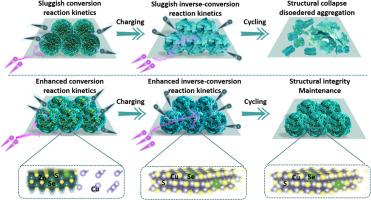揭示阴离子演化介导的优越双向动力学:硒掺杂CuS1-xSex:锌离子电池的高可逆转换型阳极
IF 20.2
1区 材料科学
Q1 CHEMISTRY, PHYSICAL
引用次数: 0
摘要
阴离子掺杂被认为是促进转化型过渡金属硫化物(TMS)阳极在摇椅锌离子电池(RCZIB)中氧化还原反应的一种很有前途的策略。然而,在转化和反转化过程中,阴离子掺杂的TMS阳极的演化途径和双向反应动力学的增强机制尚不清楚。本文选择Se作为合适的阴离子,将Se掺杂到cu (CuS1-xSex x=0.24)中,为RCZIB设计高可逆阳极。理论计算和实验结果表明,硒的掺杂通过提高CuS1-xSex的电导率、优化Zn2+吸附行为和降低放电过程中的反应能垒,显著提高了CuS1-xSex的转化动力学。非原位表征表明,在转化过程中,Se阴离子被纳入放电产物(ZnS1-xSex)中。在ZnS1-xSex的充电过程中,Se阴离子通过协同效应增强了反转化动力学:提高了ZnS1-xSex的电导率,增强了Cu吸附能力,并易于分解。随后,Se阴离子通过逆反应可逆地重新掺杂到再生电荷产物(CuS1-xSex)中。得益于优异的双向反应动力学,CuS1-xSex在半电池和全电池中都表现出卓越的倍率能力和长期循环稳定性。这一探索为研究高可逆阴离子掺杂TMS阳极在RCZIBs中掺杂硒的动态演化及其双向动力学中的协同增强机制提供了新的视角。本文章由计算机程序翻译,如有差异,请以英文原文为准。


Revealing anion-evolution mediated superior bidirectional kinetics in Se-doped CuS1-xSex: a highly reversible conversion-type anode for zinc-ion battery
Anion doping has been regarded as a promising tactic for facilitating the redox reactions of conversion-type transition metal sulfide (TMS) anodes in rocking-chair zinc-ion battery (RCZIB). However, the evolution pathways of doped anion and the enhancement mechanisms of bidirectional reaction kinetics for anion-doped TMS anodes remain unrevealed during both the conversion and inverse-conversion processes. Herein, Se is selected as an appropriate anion to be doped into CuS (CuS1-xSex x = 0.24) to design a highly reversible anode for RCZIB. Theoretical calculations and experimental results reveal that Se-doping significantly enhances the conversion kinetics of CuS1-xSex through increased electrical conductivity, optimized Zn2+ adsorption behavior and reduced reaction energy barriers during discharging. Ex-situ characterizations demonstrate the dynamic evolution of Se anions, which are incorporated into the discharge product (ZnS1-xSex) during the conversion process. The incorporated Se anions enhance inverse-conversion kinetics during charging via synergistic effects: boosted electrical conductivity, strengthened Cu adsorption capability and facile decomposition for ZnS1-xSex. Subsequently, Se anions are reversibly re-doped into the regenerated charge product (CuS1-xSex) upon reverse-conversion reaction. Benefiting from superior bidirectional reaction kinetics, CuS1-xSex exhibits remarkable rate capability as well as long-term cycling stability in both half and full batteries. This exploration provides a new insight into the dynamic evolution of doped-Se and its synergistic enhancement mechanisms in bidirectional kinetics for highly reversible anion-doped TMS anodes in RCZIBs.
求助全文
通过发布文献求助,成功后即可免费获取论文全文。
去求助
来源期刊

Energy Storage Materials
Materials Science-General Materials Science
CiteScore
33.00
自引率
5.90%
发文量
652
审稿时长
27 days
期刊介绍:
Energy Storage Materials is a global interdisciplinary journal dedicated to sharing scientific and technological advancements in materials and devices for advanced energy storage and related energy conversion, such as in metal-O2 batteries. The journal features comprehensive research articles, including full papers and short communications, as well as authoritative feature articles and reviews by leading experts in the field.
Energy Storage Materials covers a wide range of topics, including the synthesis, fabrication, structure, properties, performance, and technological applications of energy storage materials. Additionally, the journal explores strategies, policies, and developments in the field of energy storage materials and devices for sustainable energy.
Published papers are selected based on their scientific and technological significance, their ability to provide valuable new knowledge, and their relevance to the international research community.
 求助内容:
求助内容: 应助结果提醒方式:
应助结果提醒方式:


